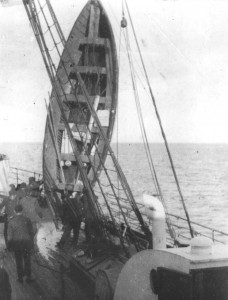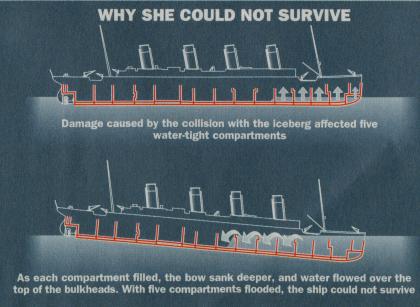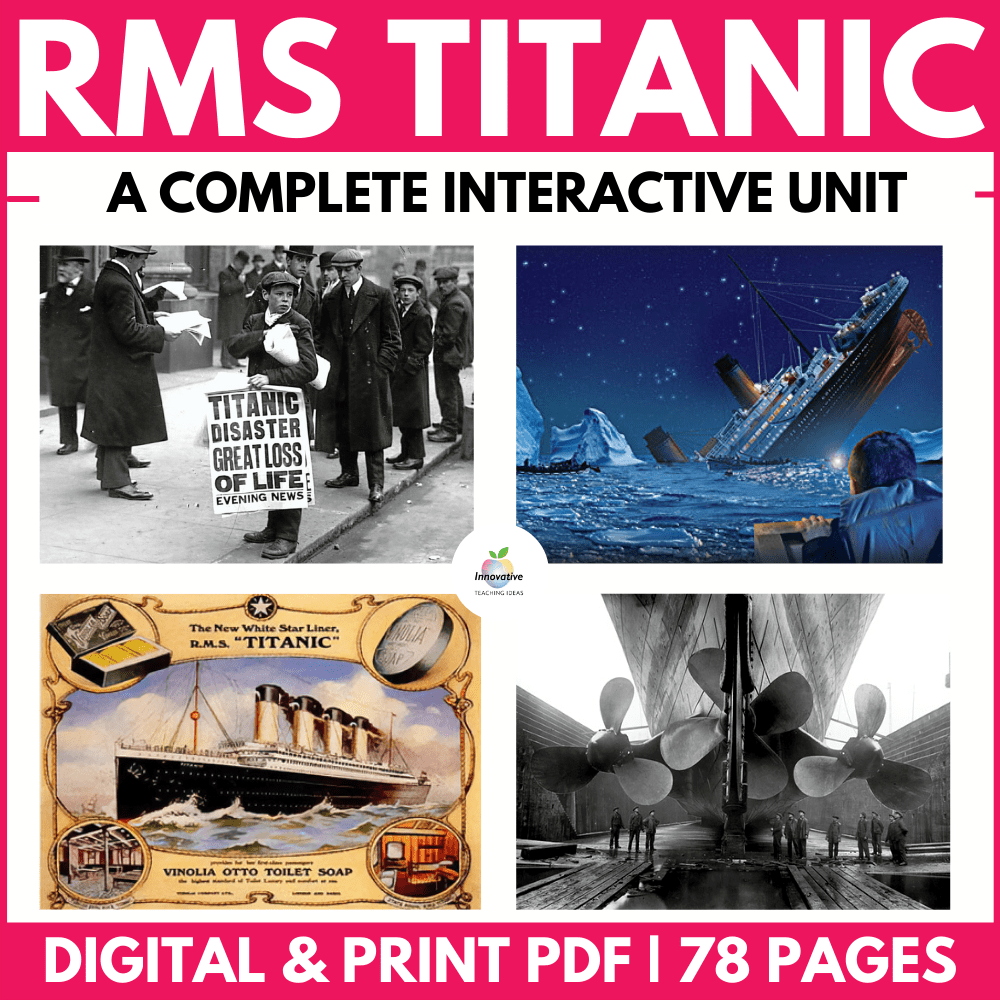TITANIC’S INNOVATION, SAFETY FEATURES AND FAILURES
Titanic was not labelled the ‘unsinkable’ ship purely by chance. She possessed several cutting-edge and well-thought-out safety features that made those involved in her construction supremely confident that she would never founder.
This section explores some of Titanic’s innovations and safety features and why it failed to meet such high expectations.
A Complete Titanic TEACHING UNIT
A complete unit of work to teach students about the historical and cultural impact Titanic made upon the world both back in the early 20th century. This complete unit includes.
Lifeboats

Nearly everyone views this as Titanic’s biggest oversight. In some ways, her designers’ arrogance at Harland and Wolff shows she did not contain enough lifeboats to carry all passengers in an emergency. Not even by half.
A lifeboat hoisted aboard Carpathia is drained of seawater.
This practice was not entirely uncommon for shipbuilders of the day for two reasons. Firstly, maritime regulations had not been overhauled for generations and did not require a lifeboat seat for everyone on board a ship of Titanic’s size. She actually had more boats than the minimum required by the board of maritime safety. Secondly, Titanic’s designers did not want to clutter decks with boats they never intended to use.
After the Titanic struck a berg, many of the initial boats lowered into the water were not even close to being filled to capacity to add insult to injury. Titanic’s crew were poorly trained in deploying them. Lifeboat number two left with 17 people on board when in fact it had been tested to carry 70 men only weeks earlier. This would be replicated until the situation became so dire that passengers and crew realized a seat on a lifeboat meant the difference between life and death.

Ironically a lifeboat drill scheduled on the morning of April 14th was cancelled to allow passengers and crew the opportunity to attend mass.
The Watertight Compartments

The primary reason Titanic was unfairly titled ‘unsinkable’ by the press during her Belfast construction phase was the innovative watertight compartments.
The concept was simple. Separate the Hull into sixteen watertight compartments using heavy-duty centrally controlled watertight doors. Where the ship’s hull is penetrated traps the water inside those compartments so that it cannot founder the entire vessel. At worst they would enable the ship to sink incredibly slowly and allow passengers to evacuate with time to spare.
One major problem was that these compartments were far from watertight as they did not possess a roof section. Essentially they were like a jar without a lid,
Therefore when the Iceberg sliced through the hull of the first six compartments, a chain reaction began of the watertight bulkhead filling up and then flooding the compartment beside it. As more flooded the faster Titanic sank.
Wireless Radio System

Titanic’s Marconi wireless system was undoubtedly the best radio system on any ship in the world in 1912. Good money was to be made from wealthy passengers sending and receiving telegraphs during the voyage. It had excellent range, and the crew were well-trained in using Morse code to communicate efficiently.
However brilliant the technology behind Titanic’s wireless system was, it would once again prove useless due to human error.
Following a discussion between Captain Smith and the radio crew about ice in the area from nearby ships, numerous ice warnings to follow were ignored and not passed on. This almost certainly reduced the impact of navigating such treacherous waters and may have influenced the decision not to reduce the Titanic’s speed.
The radio crew were overwhelmed with meeting the passengers’ communication needs, which were in high demand to be bothered with such trivial information they had already acknowledged.
As a stroke of bad fortune Titanic’s calls for S.O.S would fall on deaf ears to surrounding ships, particularly the steamer Californian which was possibly near enough to offer assistance. Essentially the radio equipment on board Californian was either turned off or not manned during Titanic’s sinking.
Detailed information on radio aspects of Titanic’s disaster can be found here.
Life vests and Buoyancy rings

There was certainly no shortage of life vests on board the Titanic. In fact, she had 3500 listed on the inventory. There were no formal complaints about the lack of vests in the following enquiries. The vests were well constructed from cork and canvas.
An authentic life vest from 1912. The life vest provided warmth to survivors onboard lifeboats.
The Titanic also carried 48 buoyancy rings. These would inevitably prove to be more a decorative component of Titanic than a practical one.
Had Titanic sunk in warmer waters closer to the equator, both of these flotation devices may have proved some worth to the many people listed as drowned. In actual fact, most of the deceased listed as drowned would have died of hypothermia before drowning. The water temperature was predicted to be around one degree Celsius which is estimated to be fatal in less than 15 minutes of exposure.
While many elements not discussed here add up to Titanic’s demise, these three elements played a crucial role.
One positive outcome of the tragedy was that Titanic would be the catalyst for revolutionizing maritime safety after such a massive loss of life. Long term, she definitely saved more lives than she claimed.
Titanic’s Propulsion System
The RMS Titanic was powered by 29 boilers and propelled by three screws (propellers) driven by steam turbines. This was considered an innovative and advanced propulsion system for its time.
The steam turbines were a relatively new technology and allowed the Titanic to reach a maximum speed of 23 knots (about 26 miles per hour). This was faster than most other ships of its era, which were typically powered by traditional reciprocating steam engines. The turbines also made the ship more efficient and allowed it to cover greater distances with less fuel consumption.
The Titanic’s propulsion system was also designed to be more reliable and efficient than traditional reciprocating engines. The turbines were designed to run at a constant speed, reducing the machinery’s wear and tear and making the ship more reliable.
The Titanic’s power and propulsion system was considered an innovation in the maritime industry, and the ship was seen as a symbol of the era’s technological advancements. The use of steam turbines in ships was still a new technology, and the Titanic was one of the first ships to feature this advanced propulsion system.



